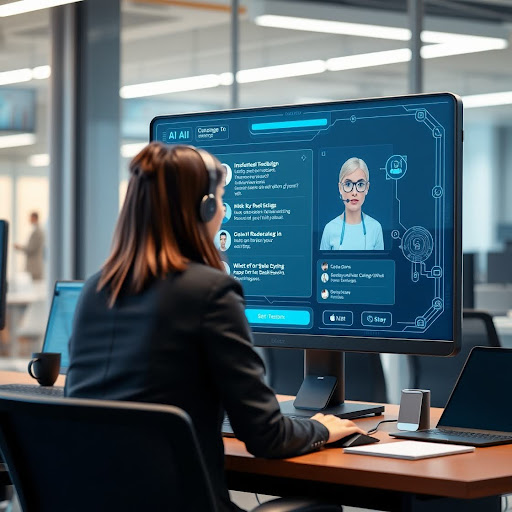Technology has evolved rapidly over the years, and one of the most fascinating advancements is text-to-speech (TTS) technology. What once started as introductory robotic narration has now transformed into lifelike AI-generated voices that can mimic human tone, emotion, and even personality.
From its early rule-based models to the latest profound learning-driven speech synthesis, AI voice technology is reshaping various industries, including entertainment, accessibility, and customer service. This article explores how TTS has evolved, where it stands today, and the future for AI-generated voices.
The Early Days of Text-to-Speech (TTS)
Converting text into speech dates back to the 1930s, when Bell Labs developed some of the first speech synthesis experiments. These early systems relied on phonetic rules to generate robotic sounds far from natural.
One of the significant milestones came in the 1960s with the introduction of concatenative speech synthesis. This method used pre-recorded snippets of human speech, which were stitched together to form words and sentences. While this approach improved speech clarity, it sounded unnatural and lacked intonation or fluidity.
In the 1990s and early 2000s, statistical parametric speech synthesis (SPSS) emerged. This method used Hidden Markov Models (HMMs) to generate synthetic voices, but the speech often sounded flat, emotionless, and robotic. At this stage, TTS was still far from achieving human-like speech.
The Rise of Machine Learning in Speech Synthesis
The breakthrough in AI-driven speech synthesis began when deep learning models were introduced. Unlike traditional methods, which relied on predefined rules or statistical models, AI-based speech synthesis allowed computers to naturally learn and imitate human speech patterns.
One of the first significant advancements was Google’s WaveNet (2016), developed by DeepMind. Unlike previous TTS models, WaveNet generated speech waveforms from scratch, creating more fluid, expressive, and natural voices.
Following WaveNet, researchers developed Tacotron 2, an AI model capable of understanding prosody, tone, and inflection, allowing it to produce speech that closely mimics confirmed human speakers. The introduction of voice cloning technology also allowed AI to replicate voices with minimal input data, making it possible to create custom AI voices.
From Robotic Speech to Realistic AI Voices
One of the most significant improvements in AI-generated voices is expressiveness. Older TTS models could only generate monotonous and robotic-sounding speech, but modern AI voices can now convey emotions such as excitement, sadness, or urgency.
This is achieved through advanced neural networks that analyze and mimic human speech patterns. Companies like Amazon (Polly), Google (Cloud TTS), and Microsoft (Azure Speech) have integrated these technologies into their products, enabling businesses to create engaging and interactive voice experiences.
Another groundbreaking innovation is zero-shot learning, which allows AI models to learn new voices instantly without extensive training. This technology has led to significant audiobook narration, voice assistants, and real-time speech synthesis advancements.
How AI-Generated Speech is Changing Industries
The impact of AI-generated speech is being felt across multiple industries. From helping individuals with disabilities to enhancing customer experiences, AI voice technology is reshaping how we interact with machines.
- Accessibility & Assistive Technology
- AI-generated voices have been life-changing for visually impaired users and individuals with speech disorders. Tools like screen readers and voice assistants allow them to interact with digital content effortlessly.
- Entertainment & Media
- AI voice technology in audiobooks, animated films, and video games revolutionizes content creation. Instead of hiring multiple voice actors, AI can generate realistic character voices in different tones and emotions.
- Customer Support & Business Solutions
- Virtual assistants like Alexa, Siri, and Google Assistant are powered by AI-driven speech synthesis. Businesses also use AI-powered chatbots and automated voice response systems to improve customer service.
Challenges & Ethical Concerns of AI Voice
Despite its benefits, AI-generated speech has ethical concerns and challenges that must be addressed.
One major issue is deepfake voices, where AI is used to replicate real people’s voices without consent. This has led to concerns about fraud, misinformation, and identity theft. Companies are developing voice authentication systems to verify AI-generated speech to combat this.
Another challenge is bias in AI speech models. Many AI-generated voices tend to favor Western accents, making it difficult for speakers with diverse linguistic backgrounds to be accurately represented. Addressing this requires better training data and greater inclusivity in AI voice development.
The Future of AI Voice Technology
AI-generated speech will become even more realistic and human-like in the coming years. Researchers are working on emotion-driven speech synthesis, where AI can adjust its tone based on context. This will make AI voices more natural in storytelling, gaming, and virtual assistance.
Another exciting development is the integration of AI voices with Virtual Reality (VR) and the Metaverse. AI-generated voices will soon play a significant role in immersive virtual experiences, allowing users to communicate seamlessly with AI-driven characters.
Conclusion
The evolution of text-to-AI voice technology has come a long way, from essential rule-based speech synthesis to deep learning-powered natural voices. With advancements in machine learning, prosody control, and real-time voice cloning, AI-generated speech is transforming accessibility, entertainment, and digital communication.
While there are ethical challenges to address, the future of AI voice technology holds exciting possibilities. As research continues, we can expect AI-generated voices to become indistinguishable from human speech, revolutionizing how we interact with machines and digital content.
Keep an eye for more latest news & updates on ToDay!




